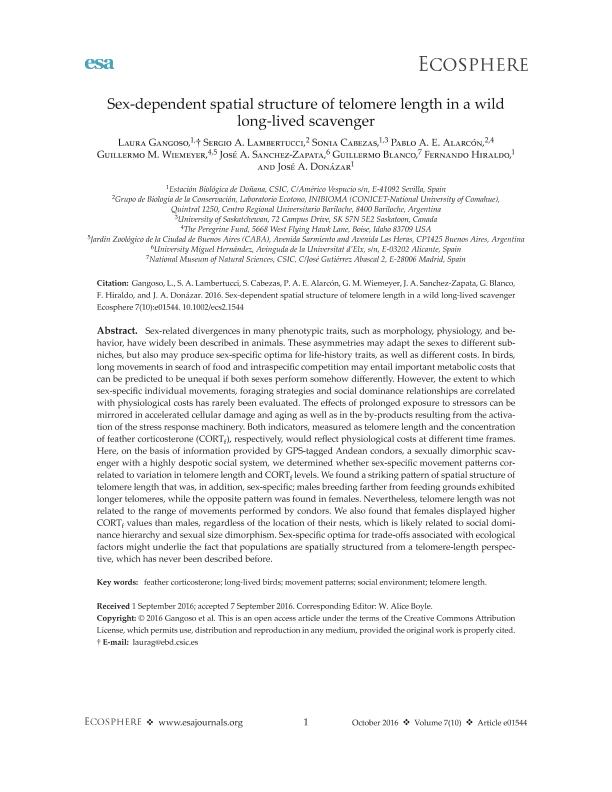Mostrar el registro sencillo del ítem
dc.contributor.author
Gangoso, Laura
dc.contributor.author
Lambertucci, Sergio Agustin

dc.contributor.author
Cabezas, Sonia
dc.contributor.author
Alarcón, Pablo Angel Eduardo

dc.contributor.author
Wiemeyer, Guillermo

dc.contributor.author
Sanchez-Zapata, José A.
dc.contributor.author
Blanco, Guillermo
dc.contributor.author
Hiraldo, Fernando

dc.contributor.author
Donázar, José A.
dc.date.available
2019-02-07T17:22:04Z
dc.date.issued
2016-10
dc.identifier.citation
Gangoso, Laura; Lambertucci, Sergio Agustin; Cabezas, Sonia; Alarcón, Pablo Angel Eduardo; Wiemeyer, Guillermo; et al.; Sex-dependent spatial structure of telomere length in a wild long-lived scavenger; Ecological Society of America; Ecosphere; 7; 10; 10-2016; 1-15
dc.identifier.issn
2150-8925
dc.identifier.uri
http://hdl.handle.net/11336/69642
dc.description.abstract
Sex-related divergences in many phenotypic traits, such as morphology, physiology, and behavior, have widely been described in animals. These asymmetries may adapt the sexes to different subniches, but also may produce sex-specific optima for life-history traits, as well as different costs. In birds, long movements in search of food and intraspecific competition may entail important metabolic costs that can be predicted to be unequal if both sexes perform somehow differently. However, the extent to which sex-specific individual movements, foraging strategies and social dominance relationships are correlated with physiological costs has rarely been evaluated. The effects of prolonged exposure to stressors can be mirrored in accelerated cellular damage and aging as well as in the by-products resulting from the activation of the stress response machinery. Both indicators, measured as telomere length and the concentration of feather corticosterone (CORTf), respectively, would reflect physiological costs at different time frames. Here, on the basis of information provided by GPS-Tagged Andean condors, a sexually dimorphic scavenger with a highly despotic social system, we determined whether sex-specific movement patterns correlated to variation in telomere length and CORTf levels. We found a striking pattern of spatial structure of telomere length that was, in addition, sex-specific; males breeding farther from feeding grounds exhibited longer telomeres, while the opposite pattern was found in females. Nevertheless, telomere length was not related to the range of movements performed by condors. We also found that females displayed higher CORTf values than males, regardless of the location of their nests, which is likely related to social dominance hierarchy and sexual size dimorphism. Sex-specific optima for trade-offs associated with ecological factors might underlie the fact that populations are spatially structured from a telomere-length perspective, which has never been described before.
dc.format
application/pdf
dc.language.iso
eng
dc.publisher
Ecological Society of America
dc.rights
info:eu-repo/semantics/openAccess
dc.rights.uri
https://creativecommons.org/licenses/by-nc-sa/2.5/ar/
dc.subject
Feather Corticosterone
dc.subject
Long-Lived Birds
dc.subject
Movement Patterns
dc.subject
Social Environment
dc.subject
Telomere Length
dc.subject.classification
Otras Ciencias Biológicas

dc.subject.classification
Ciencias Biológicas

dc.subject.classification
CIENCIAS NATURALES Y EXACTAS

dc.title
Sex-dependent spatial structure of telomere length in a wild long-lived scavenger
dc.type
info:eu-repo/semantics/article
dc.type
info:ar-repo/semantics/artículo
dc.type
info:eu-repo/semantics/publishedVersion
dc.date.updated
2019-01-23T19:03:34Z
dc.journal.volume
7
dc.journal.number
10
dc.journal.pagination
1-15
dc.journal.pais
Estados Unidos

dc.journal.ciudad
Washington
dc.description.fil
Fil: Gangoso, Laura. Consejo Superior de Investigaciones Científicas; España
dc.description.fil
Fil: Lambertucci, Sergio Agustin. Consejo Nacional de Investigaciones Científicas y Técnicas. Centro Científico Tecnológico Conicet - Patagonia Norte. Instituto de Investigaciones en Biodiversidad y Medioambiente. Universidad Nacional del Comahue. Centro Regional Universidad Bariloche. Instituto de Investigaciones en Biodiversidad y Medioambiente; Argentina
dc.description.fil
Fil: Cabezas, Sonia. Consejo Superior de Investigaciones Científicas; España
dc.description.fil
Fil: Alarcón, Pablo Angel Eduardo. Consejo Nacional de Investigaciones Científicas y Técnicas. Centro Científico Tecnológico Conicet - Patagonia Norte. Instituto de Investigaciones en Biodiversidad y Medioambiente. Universidad Nacional del Comahue. Centro Regional Universidad Bariloche. Instituto de Investigaciones en Biodiversidad y Medioambiente; Argentina
dc.description.fil
Fil: Wiemeyer, Guillermo. Jardín Zoológico de la Ciudad de Buenos Aires; Argentina
dc.description.fil
Fil: Sanchez-Zapata, José A.. Universidad de Miguel Hernández; España
dc.description.fil
Fil: Blanco, Guillermo. Consejo Superior de Investigaciones Científicas; España
dc.description.fil
Fil: Hiraldo, Fernando. Consejo Superior de Investigaciones Científicas; España
dc.description.fil
Fil: Donázar, José A.. Consejo Superior de Investigaciones Científicas; España
dc.journal.title
Ecosphere
dc.relation.alternativeid
info:eu-repo/semantics/altIdentifier/doi/https://dx.doi.org/10.1002/ecs2.1544
Archivos asociados
